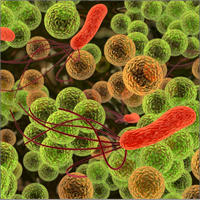New study: Gut Bacteria cooperate when life gets tough

Microorganisms that normally compete or overthrow one another can switch to a cooperative lifestyle when their living conditions change: They even start producing substances to make life easier for the other species, helping them to survive. The entire microbial community then stabilises – and together adapts successfully to the new situation.
The researchers working with Prof. Dr. Ines Thiele, head of the LCSB Group “Molecular Systems Physiology” published their results in the journal “Applied and Environmental Microbiology” (DOI: 10.1128/AEM.00101-15).
The human gut is home to thousands of bacterial species, most of which have never been described in science. This ecosystem is a complex living community: The microorganisms live side-by-side, compete for nutrients, overthrow one another or even benefit off each other.
It is the aim of Almut Heinken, research associate in Ines Thiele’s workgroup, to understand these interactions more completely: “For my thesis, I worked with data from literature and modelled on the computer how certain bacterial species respond to one another when the living conditions in their environment change,” the scientist says. “Such models are a common method for making better predictions about the interactions of bacteria. We developed the method further and applied it for the first time to gut bacteria. With eleven species, we were able to calculate how they behave pairwise in the presence of human small intestinal cells.”
Almut Heinken discovered some surprising types of behaviour in these studies: “Bacteria that are otherwise very dominant and overthrow other species suddenly enter a symbiosis with those same species if, for example, the oxygen content in the environment drops. They emit substances that make it easier for otherwise outcompeted species to survive. And they, too, receive substances they wouldn’t get enough of under the unfavourable living conditions.” Heinken has calculated such symbiotic behaviour for the bacterial species Lactobacillus plantarum, for example.
This turnaround in metabolism is vital for the bacterial community to continue functioning within the different sections of the gut: For example, the oxygen content varies in different places along the small intestine. There is more oxygen on the walls than in the centre, and more at the start of the small intestine than at its end. “By the bacteria mutually supporting one another when they find themselves in a low-oxygen environment, the bacterial community remains functional as a whole – and so the digestion as well,” Almut Heinken explains. The nutrient supply and the presence of sloughed intestinal cells also undergo great spatial variance, and have an influence on the symbiotic behaviour of the bacteria.
The LCSB researchers are interested above all in the importance of these bacterial interactions in relation to diseases, as Ines Thiele explains: “We know that diet and digestion can have an influence on the onset of diseases. This relates not only to the gastrointestinal tract, but also to other areas, such as the nervous system and its diseases, such as Parkinson’s disease.”
The scientists’ long-term goal is therefore to understand the ecosystem of the gut in minutest detail. Accordingly, they are continually adding more bacterial species to their computer models. “If we manage to correlate certain responses of the bacterial community with the outbreak of diseases, then we will gain a powerful lever,” Thiele says: “We would thereby create the opportunity to influence the disease preventatively or therapeutically by diet or by tweaking the gut flora using probiotics.”
Contact: sabine.mosch@uni.lu; T. + 352 46 66 44 6423
http://www.lcsb.lu – Homepage of the Luxembourg Centre for Systems Biomedicine
http://orbilu.uni.lu/handle/10993/20710 – Link to the scientific publication
Media Contact
All latest news from the category: Life Sciences and Chemistry
Articles and reports from the Life Sciences and chemistry area deal with applied and basic research into modern biology, chemistry and human medicine.
Valuable information can be found on a range of life sciences fields including bacteriology, biochemistry, bionics, bioinformatics, biophysics, biotechnology, genetics, geobotany, human biology, marine biology, microbiology, molecular biology, cellular biology, zoology, bioinorganic chemistry, microchemistry and environmental chemistry.
Newest articles

First-of-its-kind study uses remote sensing to monitor plastic debris in rivers and lakes
Remote sensing creates a cost-effective solution to monitoring plastic pollution. A first-of-its-kind study from researchers at the University of Minnesota Twin Cities shows how remote sensing can help monitor and…

Laser-based artificial neuron mimics nerve cell functions at lightning speed
With a processing speed a billion times faster than nature, chip-based laser neuron could help advance AI tasks such as pattern recognition and sequence prediction. Researchers have developed a laser-based…

Optimising the processing of plastic waste
Just one look in the yellow bin reveals a colourful jumble of different types of plastic. However, the purer and more uniform plastic waste is, the easier it is to…



